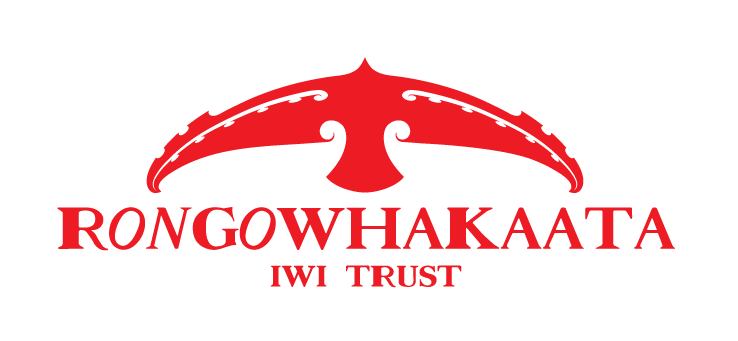Kaihautū Report 2024–2025
Teina Moetara (left) with RIT Chair Connie Maynard (middle) and Trustee Sarah Pohatu (right).
During Kaimahi hui, we recite “Ko Rongowhakaata, kai runga, kai raro, kai roto, kai waho” to activate specific Rongowhakaata values — above, below, within, and around. We set this intention deliberately to bring focus and purpose.
The kupu of Gandhi, a follower of Taranaki resistance leaders Tohu and Te Whiti, resonate:
“I do not want my house to be walled in on all sides and my windows to be stuffed.
I want the cultures of all lands to blow about my house freely.
But I refuse to be blown off my feet by any.”
The past year has been a journey of learning, resilience, and renewal. We, the organisation, remain steady through change. How? By choosing a leadership method unique to our Rongowhakaata context — a vision of practice, not an aspiration.
Our Approach
Discernment — responsibly choosing where to spend time, energy, and resources. We create reflective spaces (rongo) to ensure that our collective delivery (whakaata) is powerful. These are principles of wānanga, and we use them consciously. We remember Rongo Whakaata (child of Rangi and Papa), along with Rauru-matua (spiral, an action of ruku-i-te-pō and ruku-i-te-ao), as deities of wānanga. We assert that Rongowhakaata uri are born for this practice.
Wānanga connects the strategic values from the inner pillars of the whare to engagement at the marae ātea, the key point of action. Wānanga is therefore the actualisation of our vision: Kia tū rangatira ai a Rongowhakaata – Rongowhakaata leads with vitality.
This isn’t a 100-year vision, but a ‘now’ action. Our practice today is the realisation of this true investment strategy.
Does it solve every immediate issue? No. Will it build across time, people, and place? Yes.
Rongowhakaata individually have always been strong — often as the stone in someone else’s shoe. The question for us now is: can we evolve past the role of “a stone”?
Our kaupapa is clear: move beyond deficit narratives and stand in abundance, creativity, and rangatiratanga. The current political climate breeds deficit thinking. Our shortfalls attract government interest and funding. Some of us define our success by the acquisition of this fund. I do not. We’ve been in the Bay of Poverty long enough.
We are an iwi of artists, politicians, and grassroots leaders. How do we work together better? By choosing courage over comfort, refusing to diminish difference, and being respectful. Our strength lies not in uniformity, but in unity of purpose, listening, and practice.
Key Achievements (July 2024 – June 2025)
This report will speak to many compliance achievements, although I believe our real achievements the internal corporate systems being formally built around mātauranga — not the other way around. We continue to bring visibility to our actual work, progress, gaps, and remedies.
The activities across our Pou are like parae — playing fields or interconnected learning platforms.
Each action strengthens the whole whare.
• Pou Tuārongo: We restored native habitats, engaged kura groups, built environmental partnerships, and embedded our values in external processes.
• Pou Tokomanawa: Kura Pō participation soared, kaumātua and rangatahi engagement deepened, and new governance was inducted.
• Pou Tāhu: We advanced major developments, improved commercial readiness, and strengthened resilience with new management and risk systems.
• Pou Āwhā: We amplified iwi stories, deepened mana whenua ties, asserted our voice in regional forums, and maintained governance transparency.
Looking Ahead: Annual Plan 2025–2026
Looking forward across July 2025 to June 2026, we present eight integrated workstreams (newly refined parae) to sharpen our focus:
• Grow corridors of connection across the rohe
• Develop taiao systems to protect whenua and wai
• Advance reo and tikanga pathways for intergenerational learning
• Build research partnerships to safeguard mātauranga
• Innovate engagement through kawa and digital platforms
• Actively manage iwi-owned assets for sustainable returns
• Future-proof organisational responsiveness
• Assert mana with the Crown in all spheres of influence
These parae are anchored to the Pou of our whare and continue to be framed by He Tirohanga Whānui and He Tirohanga Whāiti. Every parae reflects a commitment to our values, to growing systems, and to practising vitality.
Closing Thoughts
I want to thank all our kaimahi from July 2024 to July 2026 for your significant work done, and in anticipation of your continued fortitude and leadership going forward. You deserve all our respect. Mei kore ko koutou, ka pōhara tātou.
To our Kāhui Kaumātua – thank you for your insight, wisdom, strength, and protection.
To our Board, Directors, and Committees – thank you for bringing your skills and care to the table. This space is special. A trust that has the trust of those it is responsible to requires both humility (rongo) and strength (whakaata).
And to you, ngā uri whakaheke o Rongowhakaata —
The year ahead calls us all to:
• Be bold
• Grow without compromising cultural integrity
• Innovate with the new while holding fast to tikanga
• Lead with vitality so every uri feels the heartbeat of Rongowhakaata in daily life
Teina Moetara | Kaihautū















